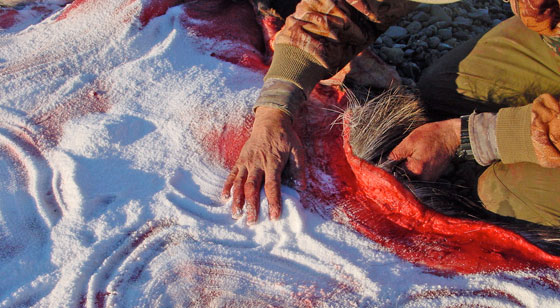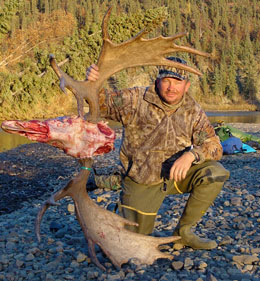Field Care of Big-Game Trophies: Salting Capes and Hides
A common question among Alaska's big-game hunters involves how much salt is needed to properly care for an Alaska big-game cape or hide in the field. The question is further impacted by weight restrictions on fly-out hunts, where limits are tight. Close attention to the following details could prevent you from making costly mistakes with your capes and hides.

General Principles
When an animal dies, the hide begins to relax and the pores start to open up. Bacteria start to multiply and begin the process of breaking the hide down. At some point, sometimes within a matter of hours, the hair begins to slip out of the hide. Proper curing of the hide tightens the hair follicles and prevents the hair from slipping. Several methods have been tried over the years, with varying degrees of success, to eliminate this problem. Here are some of the options, along with thoughts concerning each method, from respected taxidermists in Alaska.
Taxidermy and Trophy Care (TTC)
TTC bills itself as a light-weight alternative to salt. It works by drying the hide out very fast. And it weighs just a fraction of the weight of an equivalent amount of salt. The general concensus among Alaska taxidermists is summarized as follows:
1. Don't use it at all. It dries the hide out so severely that additional fleshing and detail work by the taxidermist is impossible without cutting through the hide.
2. It should only be used by individuals who are very thorough fleshing experts. Since additional fleshing is impossible after the application of TTC, the product should be only used by hunters who are accomplished fleshers who have the time and skills to do a thorough job of turning the ears, splitting the eyelids, splitting the lips and nose, and all other detail work in addition to complete fleshing.
The Bottom Line
Hunters like TTC because of the weight reduction over salt. But that's where the benefits seem to stop. It's hard to find a taxidermist in Alaska that recommends TTC. The general recommendation among Alaska taxidermists is that most hunters lack the skills or time to do a thorough job of fleshing and detail work in the field (a prerequisite for the use of TTC), therefore they do not recommend the use of TTC. If you are considering the use of this product, you must weigh its advantages against the possibility of losing your cape or hide.
Stop-Rot
Stop-Rot, a liquid chemical solution, was produced by a taxidermist in North Carolina several years ago. A few hunters have used it in Alaska, with some success. The attraction for hunters is the weight reduction over salt. However, the primary purpose of Stop Rot is to tighten up hair follicles that are already at risk of slipping hair. It is not intended for treating fresh hides, and most taxidermists do not recommend it as a field care product.
The Bottom Line
Some hunters use Stop Rot as a salt substitute, because of the weight reduction over salt. However, it is the general concensus among Alaska taxidermists we interviewed, that Stop Rot is not a tool for field use.
Salt
Regular, non-iodized table salt, or fine mixing salt, is the preferred method of curing hides in the field. If you are serious about preserving your capes and hides, you need to use salt. How much salt is needed? Naturally, it depends on the size of the cape or hide. Here are some minimum recommendations for capes and hides, listed by species:
| Species | Cape (single Salting) | Hide (single salting) |
| Bison | 25# | 50# |
| Black bear | 10# | 25# |
| Brown bear | 15# | 50# |
| Caribou | 10# | 25# |
| Deer | 5# | 25# |
| Elk | 25# | 50# |
| Goat | 5# | 25# |
| Muskox | 25# | 50# |
| Moose | 25# | 50# |
| Sheep | 5# | 25# |
| Wolf | 2# | 20# |
| Wolverine | 1# | 2# |
Note that the above numbers are for a single salting only! If you will have the cape or hide in the field longer than three or four days after the initial salting, it is very important that you give the hide a second salting. Failure to do so could result in the loss of the hair on your hide. In most cases it is wise to bring enough salt for two saltings.
Packing Your Salt
Packing your salt and shipping it to the field are important steps to consider. If you do it incorrectly, it will absorb moisture or could be accidentally spilled along the way. The cheapest, easiest ways to do this are with a "Poor Man's Dry Bag" (see video below) or by putting it in plastic five-gallon buckets.
The Salting Method
Ensure that your cape is properly fleshed before salting. It is very difficult to flesh a salted cape in field conditions. Take time to do it correctly before salting. Refer to our fleshing pages for instructions; here is a checklist of the items that must be done before salting:
|
|
|
NOTE: Blood can be removed from the hair side by soaking in running water overnight. Find a clear stream, lay the hide down hair-side up, and weight it with rocks. Note that some streams with a high iron content, heavy glacial silt load or suspended tannins in the water can stain or ruin your hide. If the water is not totally clear, don't chance it!
Once your fleshing tasks are completeted, it's time to begin salting your cape or hide. Lay the hide out, hair-side down. Some hunters prefer to do this on a tarp to keep everything clean, but this is not essential. Pour your salt in the center of the hide, and work it out toward the edges. Green (raw) hides sometimes roll back on themselves along the edges, and unless you make a deliberate effort to roll all those edges out flat, you can end up with "hot spots" where the hide is stuck together and no salt penetrates. Hair will slip in those areas. So ensure that you roll all those edges out. Rub salt all over the ears (which should remain inside-out), nose, eyelids, dewlap area, and the entire head / neck area. This means that you will have to flop the head skin over a couple of times, to get salt into all the nooks and crannies. On bears, pack salt into the toes. On full-body-skinned ungulates (goat, deer, caribou, sheep, etc), pack salt into the hooves, which have had the fat and tissue removed.
 Considerations with European Mounts
Considerations with European Mounts
For European Mounts (skull mounts without capes), remove the eyeballs and as much muscle tissue as possible from the skull, and salt the skull to keep it free from flies and bacteria. However, if you plan to have the skull cleaned with dermestid (flesh-eating) beetles, just remove the tissue without salting. The bugs don't like the salt and you'll have a hard time getting it cleaned out that way.
Wrap the skull completely with plastic before shipping, to prevent fluid leakage in transit.
Recommended Gear List
The following items are recommended by this site as a result of years of collective experience in the field working with Alaska game.
- Helle Nying knife (2 each)
- Havalon Piranta knife (1 each, with extra blades)
- E-Z Lap Model M diamond sharpener with sheath (1 each)
- Leatherman Wave multi-tool (1 each)
- ARS GR-17 folding saw, with extra blade (1 each)
- This email address is being protected from spambots. You need JavaScript enabled to view it., enough for intended harvest
- Estwing Camper’s Axe (1 each)
- Heavy-Duty Game Bags
- Citric Acid Powder
- UDAP electric fence kit for bear protection
- Flagging Tape
Additional Resources on Meat Care
- Alaska Field Care Handbook (two-part e-book by Michael Strahan)
- Field Care Handbook (book by Duncan Gilchrist)
- Float Hunting Alaska's Wild Rivers (book by Michael Strahan; contains extensive meat care section)
(ADFG Video)
